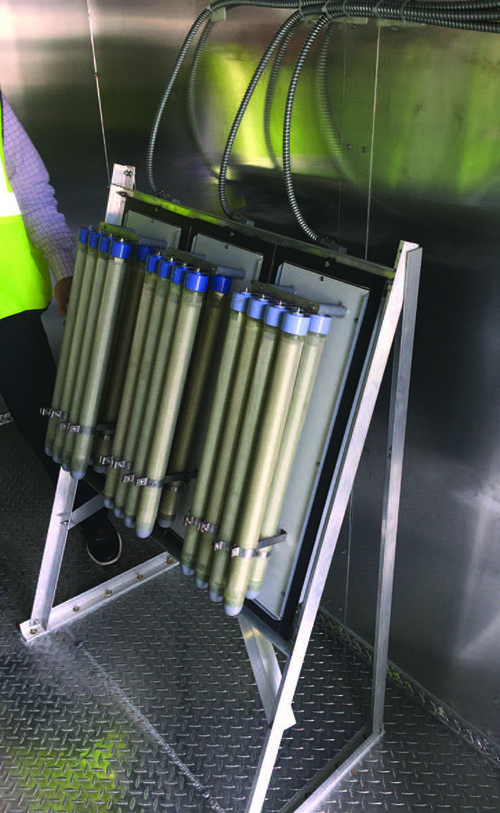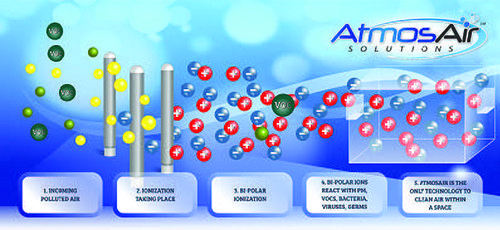With nearly 2,000 takeoffs and landings every day, Los Angeles International Airport (LAX) is keenly aware of the impact airplane exhaust from the tarmac can have on customers and employees inside the terminal.
With nearly 2,000 takeoffs and landings every day, Los Angeles International Airport (LAX) is keenly aware of the impact airplane exhaust from the tarmac can have on customers and employees inside the terminal.
 “Just like other airports, we operate terminals in the middle of our facility, and there is a lot of exhaust that creates some undesirable odors,” explains Michael Christensen, deputy executive director of the Facilities Maintenance and Utilities group of Los Angeles World Airports. “Some people are more sensitive than others. For some, the exhaust is an irritant.”
“Just like other airports, we operate terminals in the middle of our facility, and there is a lot of exhaust that creates some undesirable odors,” explains Michael Christensen, deputy executive director of the Facilities Maintenance and Utilities group of Los Angeles World Airports. “Some people are more sensitive than others. For some, the exhaust is an irritant.”
LAX combines multiple strategies to combat indoor odors and their causes.
Ultraviolet-C technology from UltraViolet Devices Inc. is used in all terminals to kill microorganisms that cause mold, bacteria and viruses. In Terminal 1, the airport also uses Genesis Air’s photocatalytic oxidation process, which captures and destroys airborne particles responsible for poor air quality.
|
facts&figures Project: Improving Indoor Air Quality Location: Los Angeles Int’l Airport Air Purification Strategies: Active bipolar ionization, from AtmosAir; photocatalytic oxidation, from Genesis Air; ultraviolet-C technology, from UltraViolet Devices Inc. Lead Designer/Architect for Bradley Midfield Satellite Concourse: Gensler Engineering: WSP |
Recently, the airport installed AtmosAir’s active bipolar ionization system in Terminal 7 to reduce inhalable particulate matter and pathogens. Looking ahead, it plans to install the company’s ionization tubes and air monitoring technology in the Tom Bradley Terminal Midfield Satellite Concourse, which is nearing completion.
“Airports are worried about the customer experience and are worried about being as sustainable as they can be,” comments AtmosAir CEO Steve Levine. “When you can create cleaner and healthier air, you positively impact people with allergies and asthma. On the employee side, you enable more productivity and improve employee retention.”
The impact of exhaust and other contaminants is not a new problem for LAX and other airports, notes Levine.
“Outdoor air gets inside airports, and Los Angeles’ outdoor air quality, although improving since the 1970s, can be bad on certain days,” he relates. “A water treatment plant adjacent to LAX doesn’t help matters. Add to that the foul odors and eye irritation caused by exhaust emanating from planes leaving and approaching the airport, and what resulted was an unpleasant and unhealthy indoor environment.”
The situation prompted the airport’s heating/venting/air conditioning department to begin seeking solutions more than 15 years ago.
“We had been getting a lot of air quality-related complaints from travelers and employees at Tom Bradley Terminal,” acknowledges Rich Yakel, LAX’s HVAC supervisor. “Bipolar ionization was just being introduced at the time, and Bradley Terminal was going through a major renovation.”
Yakel experienced the positive impact ionization systems can have on air quality while visiting a wastewater treatment plant that used the technology. “I saw, and smelled, for myself what it could do,” he recalls.
Based on his first-hand experience and additional research, LAX decided to deploy an ionization system with three different types of filters into the terminal while other renovations were being made. Although the airport saw immediate improvements in the terminal’s air quality, the new approach was costly and labor intensive.
“We operate in very tight quarters,” notes Christensen. “We have tried to deal with removing exhaust from the air. In some cases, we have used activated charcoal carbon. It became costly and maintenance-intensive to remove hydrocarbons from the air.”

Old Problem, New Solution
By working with the airport’s existing air filtration system, AtmosAir’s approach allowed LAX to improve its air quality with less time needed for ongoing maintenance.
“When airflow goes over the AtmosAir ionization tube, it creates ions that sanitize the duct and flows into the space where people are,” explains Levine. “The system takes out of the air everything people should not be breathing.”

AtmosSmart, the company’s integrated in-duct air monitoring system, connects to the AtmosAir bipolar ion units and adjusts the ion levels based on real-time air quality measurement.
The significant reduction in dust, allergens and mold spores has been stunning, reports Levine. “Irritating odors are largely a thing of the past, as is the presence of unhealthy volatile organic compounds. The amount of harmful bacteria, viruses and germs is also greatly diminished. The result is clean, odor-free air.”
According to Levine, AtmosAir’s active bipolar ionization produces the same type of positive and negative air ions that are found in mountain ranges.
“Our technology is really good at agglomerating particles in the air,” he says, noting that the technology destroys airborne contaminants rather than catching them.
Beyond enjoying improved air quality, LAX is performing less maintenance. “AtmosAir takes a lot of the load off of the carbon filtration system and reduces the amount of maintenance effort we have to put into it,” explains Christensen.
According to airport personnel, the AtmosAir system costs $17,940 per month to maintain.
Additional Applications
Gensler, lead designer and architect for the 12-gate Midfield Satellite Concourse being added to LAX’s Bradley Terminal, recognized the importance of air quality and invited AtmosAir to participate on the project.
“As designers, we use a holistic approach to ensure we create an excellent passenger and worker experience, from natural light to quality finish materials to the way people flow through the space,” says Tim Sullivan, Gensler’s regional aviation leader and lead on the Midfield Concourse project. “Indoor air quality is a crucial facet of that approach. AtmosAir’s systems are state-of-the-art, so we were glad to see they were already in use at LAX.”
When completed, the new Midfield Concourse will include more than 1,000 active ionization tubes.

Other airports using the technology to improve air quality include Portland International, San Francisco International and Ted Stevens Anchorage International.
“There are many airports that are undertaking major construction projects, and sustainability is playing an important role,” observes Levine. “Change is literally in the air.”




